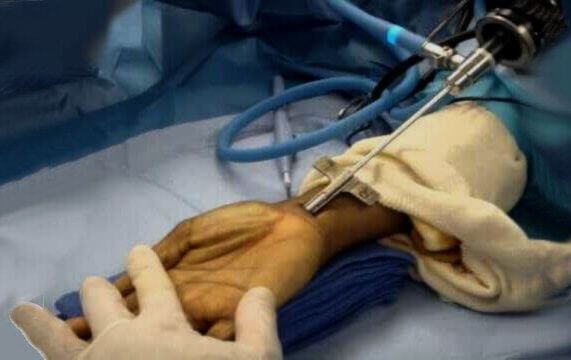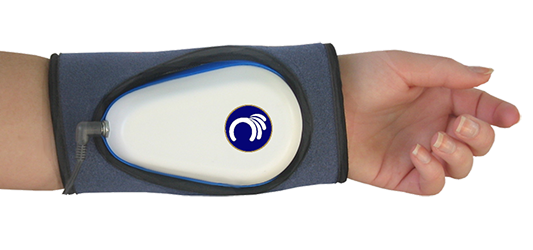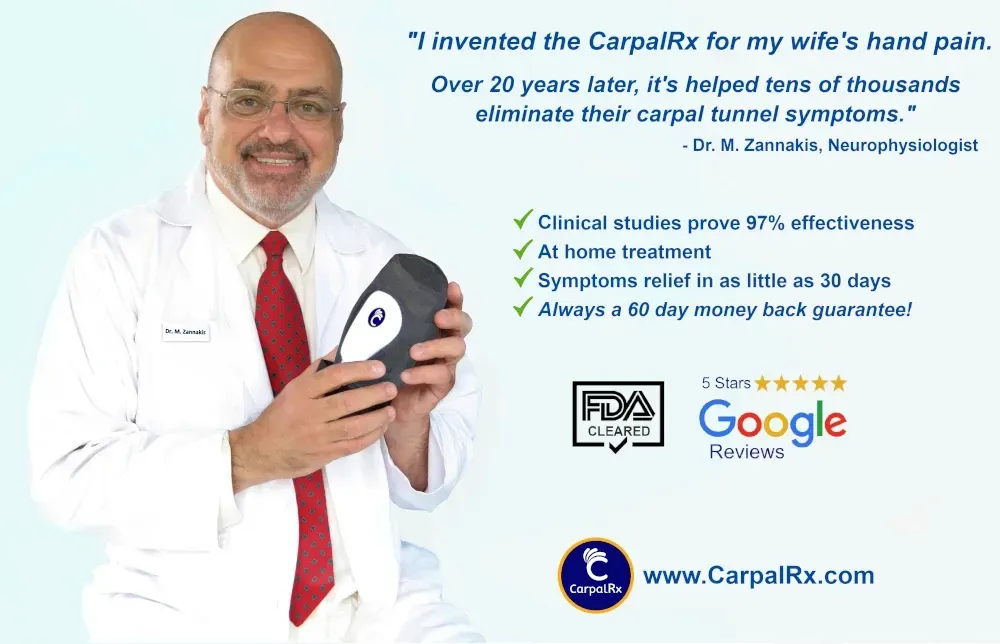A therapist performs myofascial release massage on a carpal tunnel patient.
How We Saved 88% of Patients from Having Carpal Tunnel Surgery
From Dr. Z - Carpal tunnel syndrome specialist
How We Saved 88% of Patients
From Having Carpal Tunnel Surgery
Table of Contents
- Overview
- What is Carpal Tunnel Syndrome?
- Symptoms
- Conservative Nonsurgical Remedies
- Components of CarpalRx Therapy
- Results of CarpalRx Therapy
- Significance of CarpalRx Therapy
- Summary
- FAQs
- References
- About
Overview
Carpal tunnel syndrome can cause severe pain, numbness, tingling, and weakness in the hand and fingers. Sometimes the symptoms are so intense that patients require surgery in order to get relief. About 65% of patients diagnosed with carpal tunnel syndrome have carpal tunnel release surgery to relieve symptoms. That means over 600,000 carpal tunnel surgeries are performed in the United States every year. However, about 35% of patients opt for conservative remedies instead of surgery. These nonsurgical options often are as effective as surgery for relieving symptoms. They include night bracing, stretching exercises, and myofascial release massage. The latter is a particularly powerful tool against carpal tunnel syndrome. Until the CarpalRx was invented, you had to visit a therapist to get this treatment. But the FDA cleared CarpalRx device does the identical massage automatically. For 20 years, we have tracked and analyzed thousands of CarpalRx users. We found that 97% of patients are satisfied with their results at 60 days. And by the second year, 88% of patients were satisfied enough to cancel their surgery thanks to success with CarpalRx therapy.

What is Carpal Tunnel Syndrome?
Carpal tunnel syndrome is a progressive neurological disorder. It occurs because of injury to the main nerve to your hand, called the median nerve. Deep inside the wrist joint, in a passageway called the carpal tunnel (hence the name of the disorder) the nerve becomes compressed.
Median nerve compression can occur for a number of reasons. For instance, tissue swelling during pregnancy and wrist fractures are common causes. But by far, the most common reason you get carpal tunnel syndrome is due to swollen flexor tendons. These are the tendons which allow you to flex your fingers and make a fist.
Exactly how the flexor tendons inflame and swell is unknown. But we know that
certain hand and finger activities tend to irritate the tendons. These activities include rapid and repetitive hand tasks, constant gripping, and repetitive grip-and-release movements, to name a few.
Symptoms
Carpal tunnel syndrome starts gradually. At first, you might feel pain or numbness at night while trying to sleep. These symptoms are generally concentrated on your palm, thumb, and middle fingers. Sometimes you hardly notice symptoms, or else blame them on tired and overworked hands.
But as the disorder progresses, symptoms become more overt. Then it's obvious a more serious problem exists. Other symptoms may begin to appear as well. They include tingling, burning, shooting electric shocks, weakness, and clumsiness.
Carpal tunnel syndrome typically goes through 3 stages; Mild, Moderate, and Severe. The time it takes to go through the stages varies from person to person. Generally speaking, it takes about 6 months for the disorder to advance from the Mild to the Severe stage. That’s when symptoms become maximally intense and ever-present.
At this point, many patients opt for
carpal tunnel surgery to relieve symptoms. However, a significant and growing number look towards conservative, nonsurgical remedies, which are also very effective.
Conservative Nonsurgical Remedies
The main conservative, nonsurgical remedies for carpal tunnel syndrome include nocturnal wrist bracing, stretching exercises, and myofascial release massage. In fact, the American Academy of Orthopedic Surgeons (AAOS) recommends trying these remedies first, before even considering having surgery. Why? Because they work well for most people, and they can keep patients from having to endure carpal tunnel surgery.
The AAOS also recommends that carpal tunnel patients refrain from doing what injured their hand in the first place. This is called
activity avoidance, a can go a long way toward healing your hand.

Components of CarpalRx Therapy
After two decades of assessing patients, we have found that employing the three primary conservative remedies (bracing, exercises, and massage) simultaneously is most beneficial for reversing carpal tunnel symptoms.
The CarpalRx therapy protocol is simple and easy to follow.
- Patients use the CarpalRx myofascial massager in the morning for 15 minutes.
- Then they use it a second time in the evening for another 15 minutes.
- After the evening massage, patients must brace their hand and wrist in the neutral position while sleeping.
- At least three times during the daytime, patients perform 4 carpal tunnel stretching exercises.
This protocol is followed for at least 30 days for Mild and Moderate stage patients. Patients with Severe stage carpal tunnel syndrome will likely have to follow the same protocol for at least 60 days.
Results of CarpalRx Therapy
Prior clinical studies have repeatedly shown that CarpalRx therapy has a 97% success rate at 60 days, when assessing patient satisfaction. A 2020 clinical study assessed patients in the long-term. The patient satisfaction rate was 73% at 5 years post-CarpalRx treatment.
A much larger survey was conducted between November 2006 and December 2022. We followed 369 CarpalRx patients at least every 6 months by telephone, for up to 2 years. Before trying CarpalRx therapy, all of these patients were either scheduled for carpal tunnel surgery or were considering it. All of these patients were followed for at least 6 months. And 52% were followed for at least 2 years.
We found that 96% of patients followed up to 6 months had significant symptoms relief. They either cancelled their surgery or decided to not have surgery. Of the 52% who were followed up to 2 years, 88% of those patients never had surgery.
Patients stated they were either “satisfied” or “very satisfied” with their level of symptoms remission. And by 2 years after initial treatment, 98% of these patients said they would recommend CarpalRx therapy to a friend or family member.
Significance of CarpalRx Therapy
The data we compiled is a strong indicator that CarpalRx therapy is highly effective in relieving carpal tunnel symptoms in the short- and long-term. At 60 days, CarpalRx therapy has a 97% effectiveness rate. At two years, it has an 88% success rate. These outcomes are significant in the fields of medical devices and pharmaceuticals.
For instance, compare the relief outcome of CarpalRx therapy (97% at 6 months, 88% at 2 years) to treating tension headaches with Tylenol. Tylenol eliminates headaches in only 22% of patients (1).
More importantly, compare the 88% success rate of CarpalRx therapy at 2 years to carpal tunnel release surgery at 2 years:
- Recent studies show surgery has a 50% to 80% success at 2 years based upon patient satisfaction (1).
- Various other studies report a 30% to 56% failure rate of surgery (2,3).
- Additional research reports a 30% return of symptoms following surgery (4).
- More recent research show a 5-10% recurrence of carpal tunnel symptoms after surgery (5).
Taken together, the outcomes for carpal tunnel release surgery are not very satisfying. In contrast, a 97% effectiveness at 60 days and 88% effectiveness at 2 years clearly demonstrates the superiority of CarpalRx therapy for treating carpal tunnel syndrome.
Summary
CarpalRx therapy combines myofascial release massage, night bracing, and stretching exercises. It represents a significant advancement in the nonsurgical treatment of carpal tunnel syndrome. Patient data was compiled for a period of 16 years. Outcome measurements demonstrate that CarpalRx therapy provides lasting relief of symptoms for at least 2 years after initial treatment. This conservative, nonsurgical success rate is superior to carpal tunnel release surgery when comparing symptoms remission and patient satisfaction.
FAQs
1) Does CarpalRx therapy work for everybody?
The CarpalRx has a 97% success rate at 60 days. That means that 3% of patients do not see good results, for reasons that are not clear. It has an 88% success rate at 2 years, and a 73% success rate at 5 years. These outcomes are better than carpal tunnel release surgery.
2) Does CarpalRx therapy work immediately?
No, it takes 30-60 days in most cases to see good symptoms remission. Pain usually dissipates first (by about 2-4 weeks) followed by numbness and tingling (another 3-5 weeks later). Strength and dexterity normally take longer to resolve, even after therapy has concluded.
3) How many times a day do I need CarpalRx therapy?
Clinical studies show that twice per day massage sessions (morning and evening) are optimal. However, after years of following cases, we've found that some patients have slightly quicker and more complete symptoms resolution when using the CarpalRx three times daily.
4) Can I perform myofascial massage without using the CarpalRx?
You cannot perform this by yourself because you need two thumbs to do it effectively. So you need a willing partner who can learn the technique.
References
(2) https://pmc.ncbi.nlm.nih.gov/articles/PMC3418353/
(3) https://journals.sagepub.com/doi/abs/10.1016/S0266-7681(05)80155-X
(4)
https://jamanetwork.com/journals/jama/article-abstract/385605#google_vignette
(5) https://practiceplusgroup.com/knowledge-hub/carpal-tunnel-success-rates/





